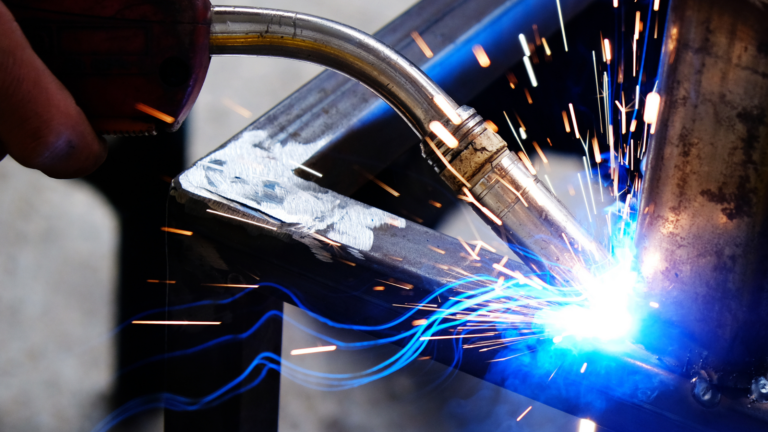Stainless steel is durable and strong, and some people choose to weld it during projects. There are many advantages to welding stainless steel. But if you’re not careful, you can make costly and time-intensive mistakes when you do.
At Pennsylvania Steel Company, we know all about the benefits of using stainless steel over other types of steel for certain projects. If you have concerns or questions about how to weld stainless steel, we’ve got you covered. Read on to learn about stainless steel welding.
Can You Weld Stainless Steel?
You can weld stainless steel — and the benefits of doing so can be significant. Some of the reasons why people choose to weld stainless steel include:
- Corrosion Resistance: When choosing between carbon steel and stainless steel, people often prefer the latter since it has a chromium oxide layer that protects against damage from chemicals, salts, and other harmful elements.
- Aesthetics: With its clean, shiny appearance, this type of steel is an attractive choice for countertops, backsplashes, and other kitchen components.
- Fire and Heat Resistance: Stainless steel has a high melting point that helps the metal maintain its integrity, even when it’s exposed to fire or extreme heat.
Types of Stainless Steel Welding
There is no such thing as one-size-fits-all with the welding of stainless steel. There are several methods that steel distributors use for welding this type of steel, including:
Stick
Stick welding, also referred to as shielded metal arc welding (SMAW), involves the use of a rod electrode and workpiece. It is often used to construct pipelines.
Metal Inert Gas (MIG)
With MIG welding, you feed a continuous solid wire electrode through a welding gun and into a weld pool to join two materials. This type of welding is commonly used for fabrication and maintenance or repair work.
Tungsten Inert Gas (TIG)
Also referred to as gas tungsten arc welding (GTAW), this type of welding requires an electric arc between a tungsten electrode and a workpiece. TIG welding is frequently used by automakers and aerospace professionals since it allows them to produce quality welds on thin materials.
Safety Precautions to Consider Before You Weld Stainless Steel
You don’t have to be a steel distributor to weld stainless steel. Regardless, there are hazards that you need to consider before you get started. These include:
Toxic Fumes
Welding stainless steel emits toxic fumes. Exposure to toxic fumes can lead to asthma, dermatitis, and other short- and long-term health problems.
You can use a fume extractor to eliminate toxic fumes when you’re welding. If you’re welding in a large area, you can install a filtration system that ensures clean air is filtered back into your workspace.
Electricity
Arc welding involves the use of electricity. Thus, you’re susceptible to electric shock when you weld.
To protect against electric shock, you should never rest your arms, legs, or any other body parts on your workpiece. Along with this, stand on plywood, a rubber mat, or other dry insulation when you’re welding. You should also wear dry gloves and never touch an electrode or metal parts of an electrode holder with your bare skin.
Injuries
Burns represent the most common welding injuries. Meanwhile, welders are also prone to eye and skin injuries.
Welding injuries often occur when welders choose not to wear personal protective equipment (PPE) or wear PPE that’s defective. Therefore, it is paramount to pick up high-quality gloves, a welding helmet, and other PPE before you start welding stainless steel. Wear your PPE any time you’re welding.
How to Weld Stainless Steel
When you’re ready, you can start welding. Doing so typically involves the following three-step process:
1. Prepare Your Steel
Remove paint, rust, oil, and other potential contaminants from your steel. Make sure that all of your steel pieces are lined up correctly and that there aren’t any joint gaps or variations. And if you have thick pieces, bevel or chamfer them as needed.
2. Weld Your Steel
Decide how you want to join your base metals. You can choose from any of the following types of joints:
- Butt Joint
- Corner Joint
- Edge Joint
- Lap Joint
- Tee Joint
You can use one or more of these options when you’re welding stainless steel.
From here, select the welding process you want to use, the appropriate inert shielding gas, and the applicable filler metal. Next, determine the parameters for your work.
At this point, you’re good to get started. Apply a low level of heat initially — otherwise, if you set the amps for your heat too high, you may compromise your project. Weld slowly and cautiously.
3. Finish Your Welding
Don’t expect perfection the first time you weld stainless steel. For example, heat tint is common when welding this type of steel. Fortunately, heat tint solutions are readily available that you can use to address this issue.
Turn to a Trusted Steel Distributor
You can weld stainless steel on your own, but doing so may be more trouble than it’s actually worth. When you have a trusted steel distributor at your side, you can get the best stainless steel products and services — without ever having to worry about welding.
Pennsylvania Steel Company has been a leading provider of stainless steel products and services for over 50 years. Our team proudly serves customers in Pennsylvania, New England, Long Island, Charlotte, and other parts of the United States. We can help you get the most value out of your stainless steel project.
Request a quote from the trusted steel distributors at Pennsylvania Steel Company for stainless steel for your next project.




